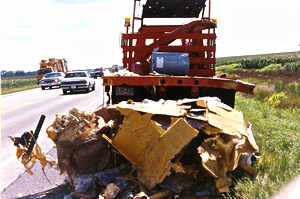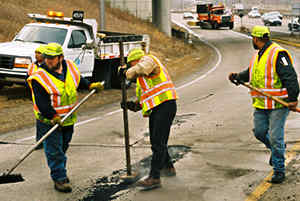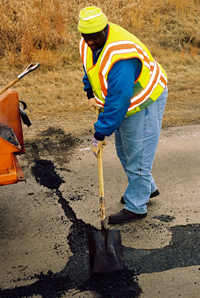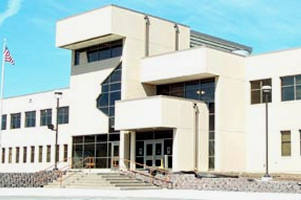 |
 |
|
 |
Minnesota's river season begins |
 |
 |
 |
Lt. Gov./Commissioner Carol Molnau, aboard the towboat Itasca, gets
some background from Lee Nelson, Upper River Services LLC. Photo
by Sue Stein
|
Lt. Gov./Commissioner Carol Molnau, Assistant Commissioner of Agriculture Perry
Aasness and St. Paul Port Authority President Ken Johnson officially opened
the Twin Cities navigation season by sounding the towboat Itasca's whistle on
the Mississippi River in St. Paul on April 4.
"As a farmer, I know how important waterway transportation is in bringing our
Minnesota products to market," said Molnau.
Minnesota ships about 33 percent of its agricultural crops to export markets;
more than 60 percent of that goes by waterway to the Gulf of Mexico for export
to world markets.
In 2002, Minnesota exported 9.5 million tons of grain via the river waterway
system. Annually, Minnesota ships and receives between 16 million and 17 million
tons of freight by river. According to Dick Lambert, Ports and Waterways director,
if that amount were shipped by truck it would add about 660,000 trucks to the
roadways during the shipping season or more than 2,500 trucks daily.
Other exports include potash, asphalt, scrap iron and petroleum. The river
system brings sand and gravel, fertilizer, salt, cement, coal and caustic soda
to Minnesota.
 |
The towboat Itasca worked hard last year carrying its share of the
16-17 million tons of freight that Minnesota businesses imported and
exported. Photo by Tom Collins, St. Paul Port Authority
|
"Waterway traffic is a safe, economical and environmentally friendly way to
ship bulk products and reduce congestion on our roadways," said Molnau. She
noted that waterway traffic depends on rail and truck transportation to get
products to market.
Each barge carries 1,500 to 1,650 tons of freightó15 times more freight than
a rail car and 60 times more freight than a truck. One gallon of fuel can move
one ton of freight 514 miles on the river.
Lee Nelson, Upper River Services LLC, invited the government leaders to mark
the occasion, which formally begins the Twin Cities navigation season.
Minnesota has five ports on the Mississippi and Minnesota riversóMinneapolis,
St. Paul, Savage, Red Wing and Winona.
For more information on waterway navigation, check out the Web site at: tp://www.dot.state.mn.us/boat.html.
To read the
news release of this event, check out Mn/DOTís News
and Views Web page, which contains links to other recent news releases.
By Sue Stein |
back

|
 |
Injured worker to speak during upcoming Workers Memorial Day observance |
 |
 |
 |
The striping support truck in which Brian Bruckhoff and Cliff Vaske
were injured rests on Hwy 15 after being struck by a semi-trailer truck
in 1990. Photo by the State Highway Patrol, Mankato Office
|
It came, quite literally, out of the blue, on a bright summer day on Aug. 13,
1990. But around about 2 p.m. a semi-trailer truck crashed into the supply vehicle
for a Mankato/District 7 striping operation on Hwy 15 north of New Ulm. Injured
in that crash were transportation generalist Brian Bruckhoff and senior transportation
generalist Cliff Vaske.
Although Vaske had only slight injuries and returned to work the next day,
Bruckhoff suffered serious injuries to his head and shoulder. He underwent several
surgeries plus months of rehabilitative therapy before returning to work in
traffic, right of way and design. After the crash, he passed the technicianís
test and now serves as a squad leader in detail design.
The 1990 crash left Bruckhoff with a weak left shoulder and arm along with
an intense commitment to improving work zone safety.
Bruckhoff will recount these experiences at the observance of Workers Memorial
Day in Mankato on Apr. 28. He will share speaking duties with Lt. Gov./Commissioner
Carol Molnau and others.
"I am one of the lucky ones who is still around," he said. "The
main thing I plan to say is that we need to watch out for each other; we canít
watch out for everything. We need to help each other and to increase the publicís
awareness about work zones to increase our safetyóand theirs."
By Craig Wilkins
|
back

|
 |
Moving day arrives for Transportation Management Center |
 |
 |
The long anticipated move from the Traffic Management Center, perched on the
south end of downtown Minneapolis, to the new Regional Transportation Management
Center next to the Waters Edge building in Roseville began Friday, Apr. 11.
Since the move started at 9 a.m., control room staff was already operating from
the new facility. A steady caravan of moving vans and workers were busy throughout
the day delivering equipment and boxes. On Monday, Apr. 14, about 40 TMC employees
reported for duty at the new location.
"The move went very smoothly," said Nick Thompson, operations manager.
"Itís fantastic that we were able to be up and running so quickly."
During the following weeks, additional employees will move into offices in
the RTMC, including Central Office employees assigned to RTMC along with the
rest of the former Freeway Operations staff from Waters Edge. Metro Districtís
Maintenance Dispatch and the Minnesota State Patrol Dispatch staff will move
in sometime in May.
The Regional Transportation Management Center staff will coordinate Mn/DOTís
traffic management efforts in the Twin Cities metro area. Staff in the state-of-the-art
central control room will monitor traffic incidents using nearly 230 closed
circuit televisions mounted along 210 miles of Twin Citiesí freeways.
Motorists receive much of this information through traffic reports on radio
and television, Web site, telephone service and 60 electronic message boards
located throughout the freeway system. Staff will also continue to provide traffic
information to local radio and television traffic reporters.
The RTMC will also monitor and control the ramp meter system; provide motorist
assistance through the Highway Helper program; and participate in Intelligent
Transportation Systems initiatives and other research.
Mail will continue as usual with daily deliveries. New phone numbers will soon
be available in GroupWise. Employees will still receive phone calls via their
old phone numbers for the next several weeks. The reception desk phone number,
however, is now (651) 634-5300. Information about tours of the new facility
will be available soon.
For more information about happenings in Metro, visit the Metro online newsletter
at: Metro Division: http://ihub.metro.dot.state.mn.us/newsletter/
(current edition)
By Kent Barnard
|
back

|
 |
Quick action by Rochesterís Brad Horn saves trapped motorist |
 |
 |
 |
Brad Horn, transportation specialist, Rochester/District 6 Construction
Office. Photo by Craig Wilkins
|
A motorist whose car left the road flipped and starting burning has Rochester/District
6ís Brad Horn to thank for extricating him from a perilous situation.
Horn, a transportation specialist in Construction, was applying salt to Hwy
14 near Lewiston early in the pre-dawn hours of Apr. 4 when he saw the car overturned
in the ditch, with flames coming from the engine compartment.
Horn grabbed his fire extinguisher and raced to the vehicle, not knowing if
anyone was still inside. As he put out the flames, he heard someone banging
on the window. Even though he couldnít see anyone in the darkness, Horn smashed
the passengerís side window and freed the driver, who escaped with just a few
scratches.
The District 6 Rochester/Owatonna News covered the incident and provided
this assessment: "Although Horn doesnít consider himself a hero, the story
highlights again the importance that Mn/DOT snowplow crews play at providing
not only safe driving to motorists, but also being there to potentially save
lives while theyíre not plowing snow."
For more on this story, visit Connections, the Rochester/District 6 online
newsletter at: http://ihub.d6.dot.state.mn.us/newsletter/
By Craig Wilkins
|
back

|
 |
Mild winter doesnít bring pothole relief |
 |
 |
 |
The same heavy traffic that contributes to pothole formation also
requires that patching crews keep an eye out for potential safety problems.
Photo by David Gonzalez
|
Potholes have begun to show up again on roads throughout Minnesota, heralding
the changeover from winter to spring and back again...and back to spring again.
Minnesotaís unusually mild winter, however, has neither increased nor decreased
the number of potholes, according to Jim Michael, Mn/DOT Metro District maintenance
superintendent, saying that the number of potholes is about average this year.
Michael noted that there were fewer freeze-thaw cycles in the Twin Cities Metro
area this year, which may have offset other factors that increase the occurrence
of potholes, he said. Generally, the more freeze-thaw cycles in a season, the
more potholes can develop.
Potholes form, he said, when moisture seeps into cracks in the pavement. As
temperatures drop, water freezes and expands and the pavement cracks grow. As
the temperature rises, the water thaws and contracts, leaving larger cracks
behind.
Demand increasing on aging roadways
Two other factors play a growing role in creating potholes: age plus cumulative
stress from the weight of traffic using the road.
As roadways age, cracks begin to form. The older the road, the more cracks
it usually has. Minnesotaís state and interstate highway system is quite old
for modern-day highways: about 75 percent of Minnesotaís state highway system
was originally built more than 30 years ago. About 33 percent has been around
for more than 50 years.
 |
The steam rising from this winter pothole being patched by Metro District
maintenance supervisor Dewayne Jones will give way soon enough for summer's
heat. Photo by David Gonzalez
|
The weight of vehicles on a road's surface also causes cracks to occur. The
more vehicles that travel on a given road, the more cracks are likely to form
there. The number of vehicle miles traveled, on Minnesota's roads has nearly
doubled over the past 20 years. Population increases account for some of this
additional mileage: Minnesotaís population increased by 21 percent during the
same period.
"As the system ages and demand on highways increases," Michaels said,
"it makes our roadways more susceptible to porthole formation."
Preventive maintenance
Last year, Mn/DOT spent $6 million to patch roads and repair potholes on
the stateís 12,000 miles of state highways. But sometimes prevention is the
key; a Michigan study found that preventive maintenance could save $8 in future
costs for every dollar spent on preventive work.
The first step in Mn/DOTís prevention program is assessment. Using lasers and
cameras to evaluate the quality of pavement around the state, Mn/DOTís engineers
and technical staff have identified about 36 percent of
the stateís highway miles as eligible for preventive maintenance in 2003.
Repair crews can use about eight to ten different procedures to prevent potholes
from forming. This is good news for drivers: fewer motorists should need to
repair a torn muffler or replace blown tires.
By Patricia Lund
|
back

|
 |
St. Cloud Conference Center opens |
 |
 |
 |
The new St. Cloud headquarters for Baxter/District 3B will play host
to many government agenciesí meetings using the new St. Cloud Conference
Center. Photo by Vickie Paul
|
Mn/DOT staff and employees will have a new place to meet in the center of the
state beginning Thursday, May 1. Thatís when Baxter/District 3 will officially
open their new St. Cloud Conference Center in the Mn/DOT St. Cloud building
at 3725 Ė12th Street North.
The new conference center, which is easily accessible from several major highways,
will host meetings, conferences, seminars, and training for government agencies
(federal/state/county/city) conducting government business.
The center has five rooms, including three conference-style rooms with modular
walls for expansion plus two committee rooms. It will operate from 8:00 a.m.
to 4:30 p.m. Monday through Friday. Reservations are required two weeks in advance.
For more information or to reserve a room, please contact Tina Warwick at 320/255-2959;
toll-free 1-800-657-3961 or via e-mail at: stcloud.conference@dot.state.mn.us.
By Vickie Paul
|
back

|
 |
|
 |



